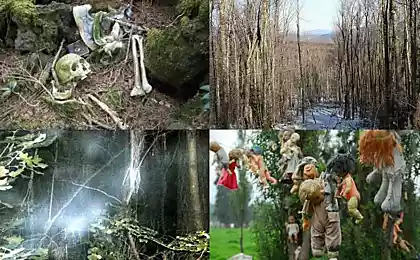252
Singing forest: The incredible experiment of the musician changed the ecology of the whole region

How music affects tree growth
Imagine a forest where every branch, every foliage resonates with melodies, bringing nature to life. This is exactly what experimental musician Fernando Ribeiro did in a small region in southern Brazil. His goal was simple but ambitious: to find out if music could help the forest grow faster and healthier.
Fernando installed special acoustic systems in the forest that played classical music, jazz and even natural sounds such as bird singing and ocean noise every day. Within a few months, it became apparent that the trees listening to music grew faster than their neighbors, and their leaves became more saturated in color.
"We wanted to prove that sounds can not only be a pleasure for humans, but also an important factor in influencing the environment," explains Fernando. His project inspired ecologists and scientists, and also attracted the attention of the world media.

The phenomenon of "singing" plants
Surprisingly, plants do respond to sounds. Studies show that they pick up vibrations through their cells. Moreover, some plant species can make sounds inaccessible to the human ear. This phenomenon is called the “singing forest”.
With the help of special equipment, Fernando was able to convert electromagnetic signals emitted by plants into melodies. Thus, the trees began to “play” their music, reacting to the surrounding sounds. He included these melodies in his musical compositions, creating a real symbiosis of nature and art.
“Each tree is unique and its song reflects health, soil water levels and even exposure to sunlight,” Fernando said.
Experiments on the influence of sounds on nature
Fernando's experiments were not the only ones in their field. Scientists from different countries have also studied how sounds affect plants. Here are some surprising discoveries:
- China: Studies have shown that certain sound frequencies accelerate the germination of seeds and increase yield.
- Italy: Vineyards, where classical music played, gave a better harvest than usual.
- Japan: In gardens that used the sounds of water and wind, the plants were more resistant to disease.
Music becomes a bridge between man and nature, helping not only to enjoy sounds, but also to create a more harmonious ecosystem.
Simple Ways of Musical Meditation
You can feel a connection to nature through music and sounds. Here are some simple music meditation techniques you can use at home or outdoors:
- Forest sounds: Turn on recordings with birds singing, wind noise or creek murmur. Listen to them with your eyes closed, imagining yourself in the forest.
- Instrumental music: Choose compositions without words that help you relax and concentrate.
- Creating sounds yourself: Try using simple instruments like a drum or flute to create your music.
- Combination of sounds: Mix natural and musical sounds to create a unique sound palette.
- Breathe in beat: Synchronize your breathing with the rhythm of the music to enhance the effect of relaxation.
These exercises help not only to improve mood, but also to establish inner harmony.
Scientific Evidence for the Power of Sound
Modern research confirms that sounds have a huge impact on biological systems. Scientists have found that sound waves of certain frequencies can stimulate cell growth, improve metabolism and even accelerate the healing process of wounds.
Music also affects a person’s mood by activating areas of the brain associated with pleasure and relaxation. The same principles apply to plants whose vibrations stimulate internal processes such as photosynthesis.
“Sound is more than just a wave. It’s a tool that can change the world, says Dr. Lian Zhou, a sound therapy researcher.
Conclusion
Fernando Ribeiro’s “Singing Forest” project is not only an amazing experiment, but also an inspiration for everyone who wants to make the world a better place. His work showed that music can not only unite people, but also help nature.
Try to incorporate music into your daily life, or take time for the sounds of nature to feel how they change your mood and state. Perhaps you will discover a new dimension of harmony with the world.
A city without loneliness: How ordinary people created a place where there are no sad people
The boy who paints the future: The story of a young artist whose paintings come true






















